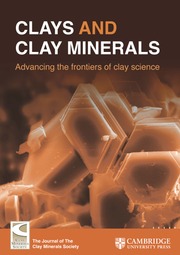Article contents
Mineralogical and Geochemical Characteristics and Genesis of Hydrothermal Kaolinite Deposits within Neogene Volcanites, Kütahya (Western Anatolia), Turkey
Published online by Cambridge University Press: 01 January 2024
Abstract
The Kütahya kaolinite deposits are the most important source of raw materials for the ceramics industry in Turkey. To date, no detailed mineralogical or geochemical characterizations of these materials have been carried out; the present study aims to fill that gap. The Kütahya kaolinite deposits formed by alteration of dacite and andesite tuffs related to Neogene volcanism whichwas associated withe xtensional tectonics. The kaolinite deposits contain silica and Fe- and Ti-bearing phases (pyrite, goethite, and rutile) in vertical and subvertical veins that diminish and then disappear upward. Mineralogical zonation outward from the main kaolinite deposit is as follows: kaolinite ± smectite + illite + opal-CT + feldspar; feldspar + kaolinite + quartz + smectite + illite; quartz + feldspar + volcanic glass. The veins and mineral distributions demonstrate that hydrothermal alteration was the main process in the development of the kaolinite deposits of the area. The very sharp, intense, diagnostic basal reflections at 7.2 and 3.57 Å, as well as non-basal reflections, well defined pseudohexagonal to hexagonal crystallinity with regular outlines, ideal differential thermal analysis-thermal gravimetric curves, and ideal, sharp, infrared spectral bands indicate well crystallized kaolinite. Micromorphologically, the development of kaolinite plates at the edges of altered feldspar and devitrified volcanic glass indicates an authigenic origin. Lateral increase in (SiO2+Fe2O3+MgO+Na2O+CaO+K2O)/(Al2O3+TiO2) from the center of the kaolinite deposit outward also indicates hydrothermal zonation. Enrichment of Sr in altered and partially altered rocks relative to freshvolca nic-rock samples demonstrates retention of Sr and depletion of Rb, Ba, Ca, and K during hydrothermal alteration of sanidine and plagioclase within the volcanic units. In addition, depletion of heavy rare earth elements (HREE) relative to light rare earth elements (LREE) in the kaolinized materials may be attributed to the alteration of hornblende. The negative Eu anomaly suggests the alteration of feldspar by hydrothermal fluids. The isotopic data from kaolinite and smectite indicate that hydrothermalalteration processes developed at 119.1–186.9°C and 61.8–84.5°C, respectively. Thus, the kaolinite deposits formed by hydrothermal alteration of volcanic glass, feldspar, and hornblende by a dissolutionprecipitation mechanism which operated under acidic conditions within Neogene dacite, andesite, and tuffs.
Keywords
Information
- Type
- Article
- Information
- Copyright
- Copyright © The Clay Minerals Society 2011
References
- 25
- Cited by

